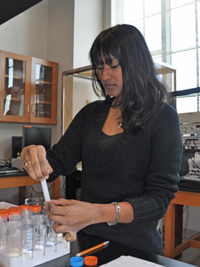

There is a narrow window of dosage between when anesthetics are useful and when they become dangerous—even lethal. Smith senior Shikha Goel believes that small molecules called endozepenes, found naturally in the brain, may be used for general anesthesia without the risks posed by traditional anesthetics synthesized in the laboratory.
/ Published February 11, 2011
Many Smith seniors studying in the sciences are using their final year to dig deep,
ask questions, and conduct original research for honors theses that open new horizons and
make discoveries new to science. Insight has profiled three of those projects.
Widely used for over a century and a half, anesthetic drugs that make patients unconscious before surgery are easy to take for granted, but these compounds can be highly volatile and toxic if dosage is not precise. This “narrow window” of dosage between when anesthetics are useful and when they become dangerous—even lethal—underscores the need to identify safer options with the same anesthetic properties, according to Shikha Goel ’11. To complete her honors thesis in neuroscience this year, Goel is following up on a lead that small molecules called endozepenes, found naturally in the brain, may be used for general anesthesia without the risks posed by traditional anesthetics synthesized in the laboratory.

Shikha Goel ’11
Goel says finding naturally occurring compounds, which the brain uses normally, may prevent the “dicey game” that doctors must play in administering anesthetics to many patients, particularly children, in whom safe and lethal doses are very similar.
Since neurons encounter these compounds normally, “Endozepenes are bound to be less toxic than something that is designed in the lab to put you under,” Goel continues.
Endozepenes were recently found in the brains of patients suffering from recurrent stupor, a condition that involves bouts of coma and consciousness. Some scientists have suggested that endozepenes may affect consciousness by slowing down brain activity in the same way as would other general anesthetics, such as propofol, used before surgery. The first step in determining this involves isolating these mysterious endozepenes and seeing whether they behave like anesthetics.
General anesthetics induce unconsciousness in patients by changing the way messages are sent from neuron to neuron in both the brain and nervous system throughout the body. Normally, these cells communicate a positive electrical message, called an action potential, which passes through thousands of neurons via positively charged particles before reaching its recipient (which is often a particular gene that triggers certain proteins to be produced).
GABA receptors, found on the surfaces of neurons, dampen brain activity to ensure that messages are sent at the proper rate and to the proper places. A failure to deliver the message results in unconsciousness, while too much activity in the brain can cause seizures and electrical connections to go haywire, delivering messages to the wrong recipients.
“GABA receptors strike a balance in the brain,” says Goel. When particular GABA molecules bind to these receptors, they decrease the positive message traveling between neurons and send a negative one of their own by allowing negatively charged particles to flow into cells. The negative message causes muscles to relax and reduces anxiety. Anesthetics such as propofol cause unconsciousness by binding to GABA receptors and enhancing the negative message.
Goel wants to find out whether endozepenes, thought to be secreted by neuronal helpers called glial cells, might function in a similar way—and to ultimately determine whether the molecules could be exploited for anesthesia.
Instead of using neurons, Goel manipulates human embryonic kidney cells to express the same GABA receptors that brain cells usually do. She then washes the cells with propofol and endozepenes. An electrode allows her to measure the negative message inside the cells, an indicator of anesthetic activity, and compare activity for the two compounds.
If Goel finds that endozepenes control neurons in much the same way synthetic anesthetics do, she will try to determine the concentrations at which that process works most efficiently. But the road between laboratory and clinical use is a long one.
Goel explains, “After researchers discover that a novel anesthetic is comparable to a known anesthetic, tests must be done on mice and eventually humans before the novel anesthetic can be implemented in hospital procedures.”




















